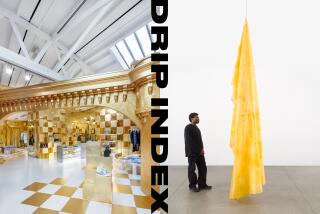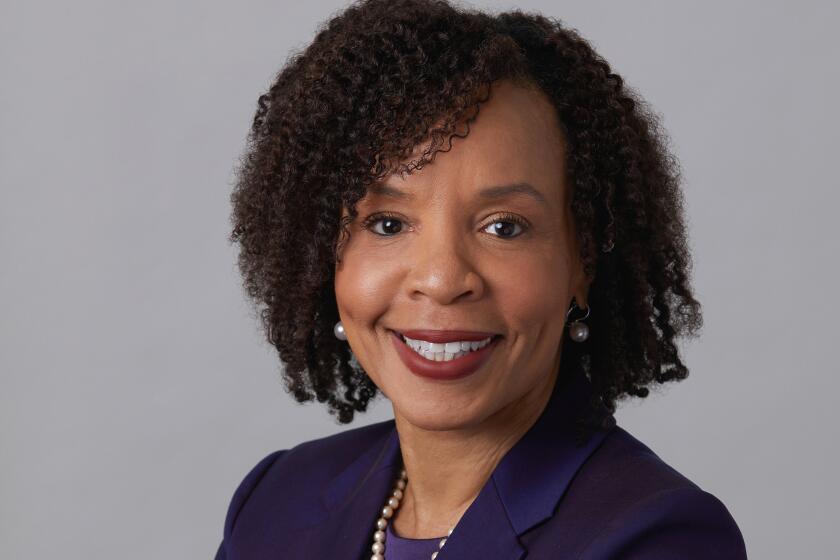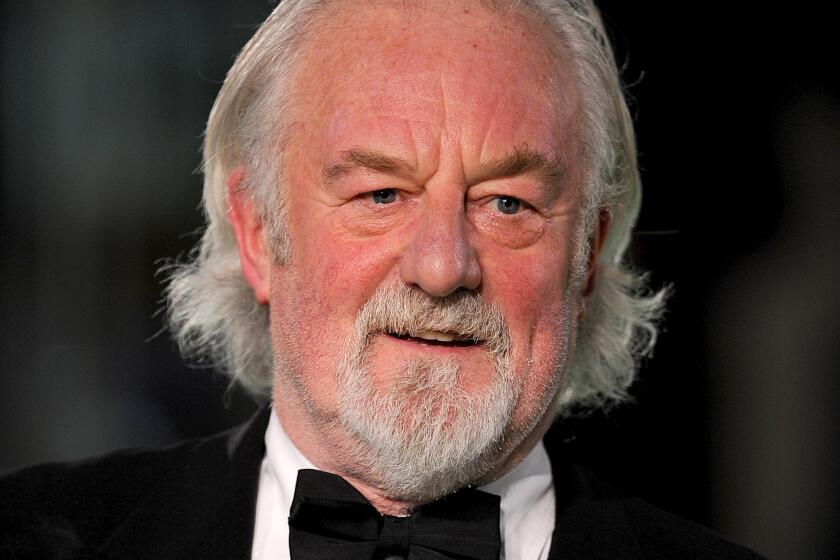Faces to Watch 2014: Art | Anne Ellegood, Phillip K. Smith III, Gabriel Kuri
The Times asked its reporters and critics to highlight figures in entertainment and the arts who will be making news in 2014. Here’s who they picked:
Anne Ellegood | Curator
Hammer Museum Senior Curator Anne Ellegood will likely see some attention this spring with the debut of her long-mulled, provocative show “Take It or Leave It: Institution, Image, Ideology.”
The 35-artist historical show — co-organized by Ellegood’s friend, New York-based art historian Johanna Burton — is an institutional critique of museums themselves as it examines American artists who the curators felt have changed the way we, as a culture, think about art. Among those included in the exhibition, focusing on work largely from the ‘80s and ‘90s, are Barbara Kruger, Mike Kelley, Jimmie Durham, Adrian Piper and David Wojnarowicz.
“It’s kind of a risky show,” Ellegood says. “It’s a historical show that, woven into the curatorial approach, is also a question about historical shows themselves.”
GRAPHIC: Faces to watch 2014 | Entertainment
Ellegood says it’s important to note that the show strives to be educational and sprightly challenging, not aggressively or aimlessly critical. “The artists who are evaluating the institution are critiquing it not because they want to burn it down but because they love the institution and want it to be a better place — to be more inclusive, to grapple with the most difficult issues of the day, to be a space for dialogue,” she says.
Originally from Portland, Ore., Ellegood, 46, spent seven years honing the idea for “Take It or Leave It,” which she says grew out of casual conversations with Burton (who’s now at New York’s New Museum of Contemporary Art, which isn’t affiliated with the show). Throughout Ellegood’s four years as curator of contemporary art at the Hirshhorn Museum and Sculpture Garden in Washington, D.C., as well as her time as an associate curator at the New Museum, she couldn’t let the idea go. It wasn’t until Ellegood came to the Hammer in 2009, however, that she brought the show to life.
“In a way, it’s the show I’m most proud of,” she says.
RELATED: Faces to watch | Theater
Phillip K. Smith III | Artist
Phillip K. Smith III’s light installation “Lucid Stead” — a worn, wooden homestead shack tricked out with mirrored slats and multicolored LED lights — stood alone in a dusty desert clearing just outside Joshua Tree for two weekends in mid-October. Only 400 or so people visited the structure in person as it shimmered in the high noon sunlight and glowed red, orange and pink at sunset. The shack became something of an Internet sensation, with the video garnering more than 300,000 views on lucidstead.com and catapulting the artist into a whole new stratosphere of recognition.
Smith, 41, grew up in the Palm Springs area and spent 11 years on the East Coast after earning dual degrees in fine arts and architecture from the Rhode Island School of Design. He returned to Palm Desert in 2000, where he lives now, because “When you grow up in the desert, it’s in your blood,” he says.
Throughout his career, Smith has created more than a dozen large-scale sculptures across the country, including an over-50-foot fiberglass piece, “Inhale/Exhale,” for the University of La Verne in 2009 as well as publicly and privately commissioned sculptures in Kansas City, Mo., Nashville, Arlington, Va., and Scottsdale, Ariz., among other places. While he was the 2010 artist in residence at the Palm Springs Art Museum, Smith created a 24-foot-long acrylic sculpture backlighted by LED lights that served as the inspiration for “Lucid Stead.”
RELATED: Faces to watch 2014 | Classical music
“Lucid Stead” is no longer up, but Smith’s smaller-scale works can be seen in the show “Lightworks,” now on view at Palm Desert’s Royale Projects. The artist also will have a solo show next month at the Museum of Art and History in Lancaster. “Lucid Stead: Four Windows and a Doorway” opens Jan. 18 and will feature five works made of physical elements, taken out of context, from “Lucid Stead”; together, they constitute a new, single installation.
Gabriel Kuri | Artist
Gabriel Kuri is already a significant midcareer contemporary Mexican artist — he’s had solo museum and gallery exhibitions around the world and been part of the 2003 and 2011 Venice Biennales as well as the 2008 Berlin Biennale. In the late ‘80s and early ‘90s he was part of a collective that studied at Gabriel Orozco’s Mexico City studio. The group — which included Damián Ortega, Abraham Cruzvillegas and Dr. Lakra — regularly showed its work at the Mexico City gallery Kurimanzutto, co-owned by Kuri’s brother José.
After 10 years of living and working as an artist in Brussels, the 43-year-old Kuri moved his family to Los Angeles in August, for personal and professional reasons.
“It was great to be in Belgium, but we didn’t want to wake up there and find it impossible to leave because we’d dug roots,” he says. “Here in L.A. I’m close enough to Mexico, but I have my own space.
“Also, the arts are exciting here,” he adds. “It’s a scene of artists, not a scene that’s about the market.”
RELATED: Faces to watch 2014 | Opera
Kuri studied art at Escuela Nacional de Artes Plásticas in Mexico City before pursuing a master’s at Goldsmiths College of Art in London. His work explores consumer culture and how we repurpose the material world, both natural and artificial, via sculptures and collages created with found objects and the detritus of his everyday life — shopping receipts, ticket stubs, stray plastic bags, leftover hotel shampoo bottles as well as natural elements he finds outdoors, like marble and stones.
His work is on view at the Modern Art Museum of Fort Worth as part of the exhibition “Mexico Inside Out: Themes in Art Since 1990” (through Jan. 5). Kuri’s solo exhibition “bottled water branded water” is on view at Parc Saint Léger in France through Feb. 9.
In May, Kuri’s first L.A. solo exhibition will open at Regen Projects. He can’t yet say what exactly will be included in the show — just that he aims to make it different from anything he’s done before.
“I want it to be in the classic Gabriel Kuri tradition, for people not familiar with my work, and also it’s quite important for me to reinvent myself,” he says. “Restarting is extremely important for artists. This exhibition has to be at a zero starting point, with a reminder of where I was.”
More to Read
The biggest entertainment stories
Get our big stories about Hollywood, film, television, music, arts, culture and more right in your inbox as soon as they publish.
You may occasionally receive promotional content from the Los Angeles Times.







